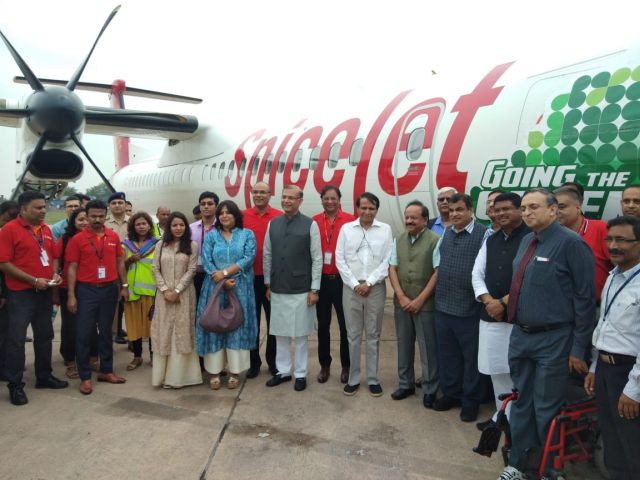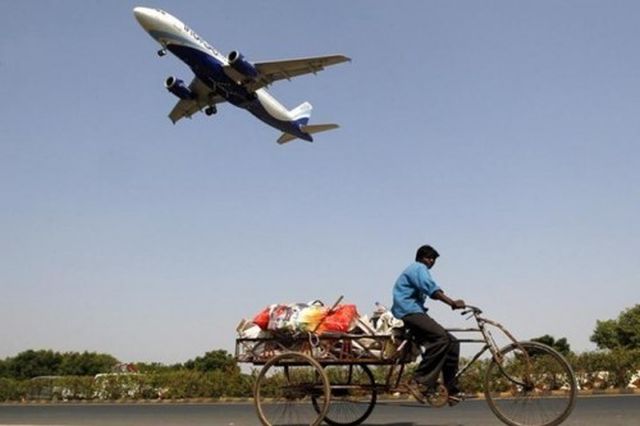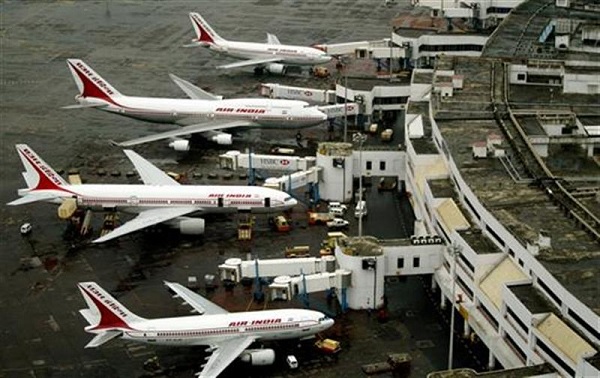
by admin | May 25, 2021 | Business, Corporate, Corporate Governance, Large Enterprise, News, Politics
 New Delhi/Dehradun : Budget passenger carrier SpiceJet on Monday successfully operated India’s first test flight partially powered by bio-fuel.
New Delhi/Dehradun : Budget passenger carrier SpiceJet on Monday successfully operated India’s first test flight partially powered by bio-fuel.
A mix of 25 per cent bio-fuel and 75 aviation turbine fuel (ATF) powered a SpiceJet Q400 turboprop aircraft on the 200 km flight from Dehradun to Delhi on Monday morning.
SpiceJet termed the operation India’s first-ever “BioJet Fuel” flight. It pointed out — reduction in carbon emissions and enhancement of fuel efficiency — as advantages of using “BioJet fuel” as compared to ATF.
The bio-fuel type made from the Jatropha crop was developed by the CSIR-Indian Institute of Petroleum (IIP), a constituent of the Council for Scientific and Industrial Research based in Dehradun.
Subsequently, 25 per cent of bio-fuel blended with ATF powered one of the two engines of the Q400 aircraft for the over 40-minute-long flight.
The aircraft ferried 28 on-board, including the crew and regulatory officials. It was received by Cabinet ministers and airline officials at the Indira Gandhi International Airport’s Terminal 2.
At an event to mark the success of the test flight, Civil Aviation Minister Suresh Prabhu said that the central government plans to come out with an environment friendly aviation action plan till 2035.
On the policy front, Road Transport and Highway Minister Nitin Gadkari said that a cabinet note on the standardisation and use of bio-fuel blended with ATF will be prepared by Ministry of Petroleum and Natural Gas.
Gadkari elaborated that bio-fuels obtained from non-edible seeds will aid in employment creations, import substitution, making transport costs effective and pollution free.
As per IATA, aviation industry contributes to 2 per cent of the total greenhouse gas emissions in the world, which will rise as the sector expands.
The development assumes significance due to high ATF prices, which have dented the domestic airline sector and led almost all players to report losses for the first quarter of 2018-19.
Presently, fuel prices constitute around 50 per cent of the overall operations cost of domestic airlines. India’s ATF prices are amongst the highest in the world due to crude oil import and addition of state levies.
The fuel is not under the GST ambit like the bunker fuel used for the shipping industry.
“Rising costs are worrying for aviation companies. The reason being the high fuel costs,” Gadkari said.
“It is approx. Rs 70 a liter, it can cost up to Rs 10 less which in turn will help… boost the aviation sector as a whole.”
According to SpiceJet Chairman and Managing Director Ajay Singh: “This fuel is low cost and helps in significantly reducing carbon emissions. It has the potential to reduce our dependence on traditional aviation fuel by up to 50 per cent on every flight and bring down fares.”
—IANS

by admin | May 25, 2021 | Corporate, Corporate Governance
 Mumbai : Credit ratings agency ICRA on Tuesday said that healthy passenger load factors, along with a decline in competitive intensity is expected to aid the Indian aviation industry to reduce its losses in FY2018.
Mumbai : Credit ratings agency ICRA on Tuesday said that healthy passenger load factors, along with a decline in competitive intensity is expected to aid the Indian aviation industry to reduce its losses in FY2018.
As per a research note by ICRA, healthy passenger load factors supported by a decline in competitive intensity due to moderation in capacity addition and suspension of operations of three regional airlines has augured well for the industry profitability.
“This coupled with a gradual improvement in the core growth drivers like economic environment, tourism demand and regulatory support and a strong demand during the peak season is expected to support the industry profitability during H2 FY2018,” the research note said.
According to Kinjal Shah, Assistant Vice President & Co-Head, Corporate Sector Ratings, ICRA, the aggregate net loss of the industry (which does not includes Vistara and AirAsia India) is expected to reduce to “Rs 50 million to Rs 1 billion in FY2018 from Rs 10 billion in the previous year”.
“It has to be noted that the loss is primarily on account of losses of Air India, while all other major airlines are expected to report profits during the year,” he said.
—IANS

by admin | May 25, 2021 | Business, Large Enterprise
 Hyderabad : (IANS) With over 20 percent growth in domestic aviation market in 2015, India is well on its way to becoming the third-largest aviation market by 2020, says a Ficci-KPMG report.
Hyderabad : (IANS) With over 20 percent growth in domestic aviation market in 2015, India is well on its way to becoming the third-largest aviation market by 2020, says a Ficci-KPMG report.
According to the report released on Thursday at the India Aviation 2016 here, with 81 million trips, the domestic aviation market grew at over 20.3 percent during January-December 2015, the highest growth rate recorded in the world.
The total passenger throughput grew by 17.1 percent in 2015-16, standing at 184 million till January 2016. Passenger throughput is expected to reach around 370 million by 2020, with domestic traffic constituting around 80 percent of the total throughput.
The report suggests that aspects such as increasing disposable incomes, fall in prices of Aircraft Turbine Fuel (ATF), increase in tourism, visa reforms, have placed India in a unique position. “This is bringing the country closer to achieving its vision of becoming the largest aviation market by 2030,” says the India Aviation 2016 report.
According to the report, the Indian civil aviation industry has exhibited tremendous resilience to the global economic slowdown and ranks ninth in the global civil aviation market. This is attributed largely to the growing economy, increased competition among airlines, especially among low cost carriers, modern airports, greater use of technology, Foreign Direct Investment (FDI) and increased emphasis on regional connectivity.
The report highlights that the National Civil Aviation Policy (NCAP 2016) is likely to provide a significant fillip to the industry. The various fiscal and monetary incentives, liberal policies focused on ‘ease of doing business’ and enhanced push for regional and global connectivity are extremely positive.
Steps taken to revive and operationalise around 160 airports in India, if chosen carefully, will improve air connectivity to regional and remote areas. Public-Private Partnerships (PPP) in the sector will get substantial support from the state in terms of financing, concessional land allotment, tax holidays and other incentives.
“Enormous growth in domestic passenger traffic, substantial strengthening through government initiatives, decrease in global crude oil prices and airlines showing profits indicates a significantly positive transformation for the Indian civil aviation market,” said Harshavardhan Neotia, president, FICCI.
“The positive impact of NCAP 2016, rise in disposable incomes and the fall in ATF prices are likely to help India leapfrog into the top three of the world,” said Amber Dubey, Partner and India Head of Aerospace and Defence, KPMGA.
He hoped that the government can match domestic ATF prices with global levels for a three year experimental period. “MRO is likely to see a huge revival if the service tax is zero-rated. Growth of aviation and tourism can create a huge multiplier in terms of GDP growth and jobs,” he added.
The report quoted International Air Transport Association (IATA) that passenger traffic on international routes showed an increase of 6.5 percent in 2015 compared to 2014.
During April-December 2015, international passenger throughput at Indian airports grew at 7.7 percent. Middle East continues to lead in the growth of revenue passenger kilometre (RPKM) followed by Asia-Pacific, Latin America and Europe. North America and Africa showed sluggish growth. By 2034, it is expected that Asia-Pacific will be the biggest market for global aviation.
The report strongly suggests that in order to ensure high-geared growth, it is imperative to broaden the base of domestic flyers through greater air connectivity in tier 2/3 cities.

 New Delhi/Dehradun : Budget passenger carrier SpiceJet on Monday successfully operated India’s first test flight partially powered by bio-fuel.
New Delhi/Dehradun : Budget passenger carrier SpiceJet on Monday successfully operated India’s first test flight partially powered by bio-fuel.

